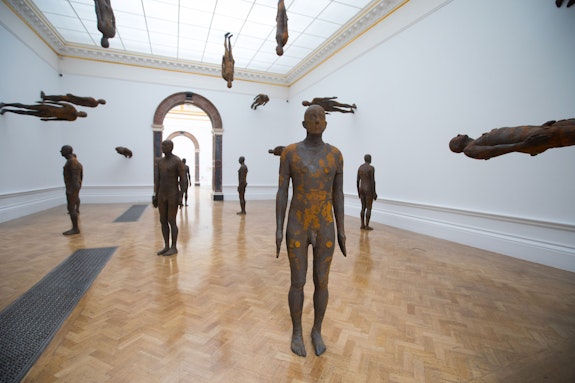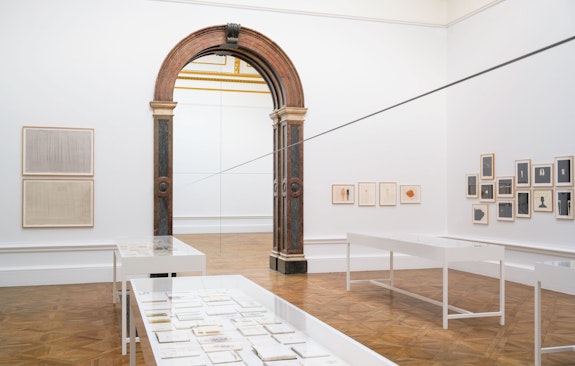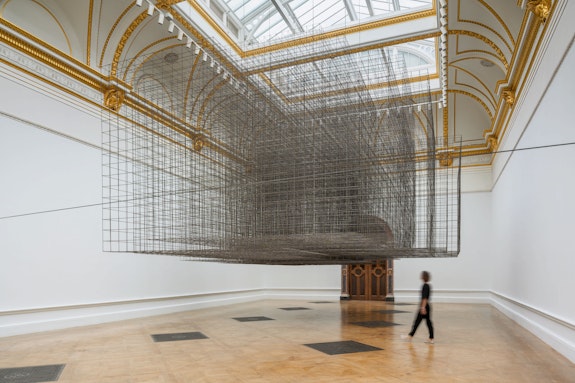ArtSeen
Antony Gormley

London
Royal Academy Of ArtsSeptember 21 – December 3, 2019
Antony Gormley at London’s Royal Academy is a confounding bundle of contradictions. With this solo show—the artist’s most significant in the UK for over a decade—curators Martin Caiger-Smith and Sarah Lea have united iconic older works with newly commissioned pieces, arriving at a blend of the imposing, the minimalist, and the aesthetically austere. Radically appropriating the Beaux-Arts architecture of the RA’s main galleries, Gormley’s work attempts to highlight the body’s relationship to both exterior space and its own nature as a site of experience.
Even before a visitor enters the RA, the 17th-19th-century building’s formal symmetry, grand size, and stately facades are used to productive effect. Approaching the entrance through the Annenberg Courtyard, it’s easy to bypass Gormley’s first piece: the life-size Iron Baby (1999). This work, based on the artist’s 6-day old daughter, lays on its stomach against the cold ground, its legs tucked up under its body. The smooth black contours of the sculpture are juxtaposed with the courtyard’s angularity, while its exposed position in the busy, open space heightens its vulnerability.

The industrial materials, often monochrome palette, and physical dispersion of Gormley’s work clashes with the propriety of the RA’s rooms and their ornate, gilded interior design. Co-ordinate VI (2019) is comprised of three high-tension steel bars that represent the axes used to measure the dimensions and positions of objects in space. Like a trio of unruly children, they flaunt the regulating structure of the institutional environment by passing impetuously through several discrete galleries. As with much here, the work is visually sparse. But it helps us to reconceive the space around us: not just as some homogenous void but as a series of culturally constructed zones, loaded with socio-historic meaning.
One of the steel bars of Coordinate VI terminates at the entrance to Clearing VII (2019), a three-dimensional scribble or “drawing in space” that we’re invited to scramble through. Imposing but permeable, both permissive and yet a hindrance, the wild, coiled loops of the installation press up against the gallery’s boundaries, altering a visitor’s typical experience of the space. Like Gormley’s Fourth Plinth Commission in Trafalgar Square (2009), where members of the public were each elevated to monumental status for an hour, Clearing VII allows the viewer to become one with the artist’s vision. Here, we help to realize a recurring motif of Gormley’s: bodies staged within other bodies, whether they are biological, architectural, or sculptural.

“When it comes to the body,” the artist has said, “any notion of ‘me’ or ‘mine’ is simply an inaccurate reflection of the fact that we are all part of bigger systems, the truth of which we will never know.” It’s a concept he turns to repeatedly. The early work Full Bowl (1977-78) comprises a series of incrementally smaller forms, fit snugly inside one another like Russian nesting dolls, while his drawing Mansion (1982) depicts a small humanoid grasping the tendons of a larger figure from within like a parasitic puppet master. Both, however, are constrained by the silhouette of a house. Notions of inside and outside, as well as self and other, are shown to be relative assessments, necessarily subject to contestation.
A number of the installations feel like undeveloped sketches—which is how many of them started, as we see from a selection of Gormley’s workbooks. Matrix III (2019), hanging over our heads at a weight of six tons, might be a triumph of engineering, but it doesn’t visually convince as, in Gormley’s words, “the ghost of the environment we’ve all chosen to accept as our primary habitat.” Instead, it remains merely a mess of steel mesh. More impressive are the 24iron casts of Lost Horizon I (2008), which both stand immobile beside us and jut out from the walls and ceiling. Unsettling our certainty about what is ‘up’ and ‘down,’ this work echoes the vertigo-inducing perspectives of graphic artist M.C. Escher. If these sculptures appear adrift in physical space—angled towards walls with closed eyes—it’s because they allude to a world of inner space, a place without limitations or co-ordinates. It’s in this “darkness of the body,” Gormley believes, that we can begin to understand ourselves as continuous with the cosmos itself.

While inviting us to be still and contemplate the void, Antony Gormley ultimately presents more of a technical accomplishment than an artistic one. The exhibition’s installation posed a three-year logistical challenge to the RA, and the necessary transformations are indeed audacious and objectively impressive. But, as Iron Baby—the one instinctively emotive piece of the show—illustrates, bigger isn’t always better. Although you might expect the physically imposing presence of works like Matrix III and Clearing VII to at least incite awe, curious indifference was instead my overwhelming response. While Gormley’s ascetic meditations challenge us to reconsider our relation to space and the world at large, they forget to enchant us as well.

